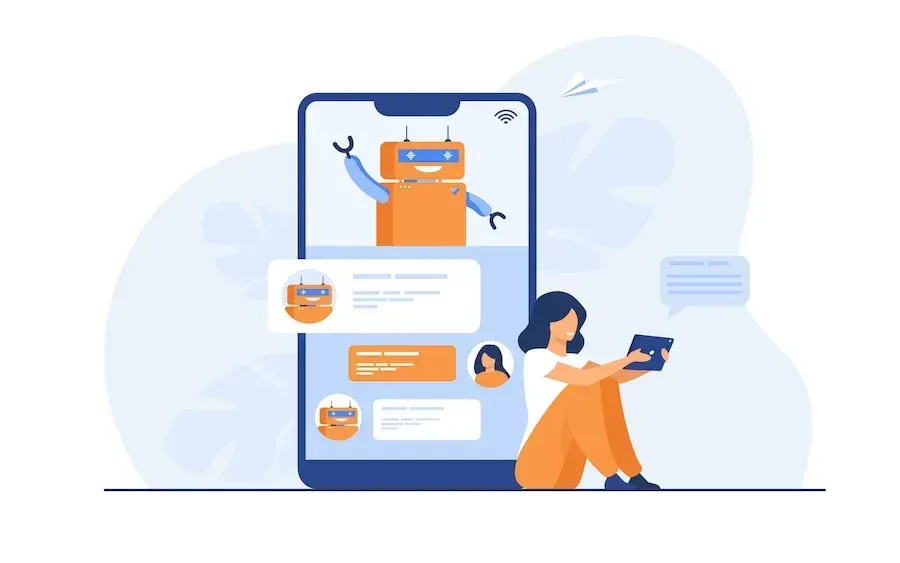ROOM 214 BLOG
LATEST NEWS & TRENDS
We’re full service which means we’ve got you covered on design and content right through to digital.

ENHANCING CUSTOMER SATISFACTION WITH CHATBOTS: HOW TO IMPLEMENT STRATEGIES FOR IMPROVED SERVICE
“The chatbot’s role in customer service is expected to grow exponentially, with chatbot markets projected to reach $24.58 Billion by 2030. ”
Introduction:
In an ever-evolving technological landscape, the concept of customer satisfaction is experiencing a significant shift. With consumers growing more tech-savvy and demands increasing, the role of technology in enhancing customer service has become paramount. Artificial Intelligence (AI), in particular, is playing a game-changing role in revolutionizing the customer service arena.

WHAT ARE CHATBOTS?
Chatbots are software applications designed to simulate human conversation. While chatbots may seem like they've popped up recently, the first chatbot was created in 1966 by Joseph Weizenbaum at MIT, and scripted chatbots have been in use since the '90s. Notable advents in chatbot technology include AOL's SmarterChild (2001), Apple's Siri (2011), and Microsoft's Cortana (2014). Today's AI-powered chatbots, however, provide seamless automated customer service solutions, including answering queries and complaints and communicating order statuses. Thanks to machine learning technology, modern chatbots have the ability to understand, learn, and respond to human interaction in a highly personalized manner.
HOW CHATBOTS IMPROVE SERVICE
Chatbots improve service by responding to queries, ensuring customers don't have to wait. Customer support chatbots offer 24/7 availability, providing round-the-clock support and ensuring robust customer service. Chatbots can remember past conversations and preferences and deliver personalized responses. It's all about making the customer feel understood and valued.
NOTEWORTHY CASE STUDIES: THE IMPACT OF CHATBOTS
Amtrak introduced "Julie," a customer service chatbot solution from Next IT, in 2012. As of today, their chatbot answers 5 million questions annually, providing a 25% increase in bookings, with bookings through chatbots generating 30% more revenue than non-chatbot transactions.
RapidMiner, a firm offering analytical and visualization software solutions for data scientists and data-centric businesses, utilizes a chatbot named LeadBot to engage with users in dialogue, capturing valuable sales leads while filtering out less beneficial interactions. This allowed RapidMiner to automate its lead qualification process, ensuring potential leads are captured around the clock so sales resources could focus on key customers.
Lemonade, an insurance firm, leverages a chatbot named “Maya” to customize insurance policies for clients within 90 seconds and manage claims and payments in under three minutes. This quick and efficient customer service has resulted in substantial cost reductions for the company.
IMPLEMENTING CHATBOTS: A STEP-BY-STEP GUIDE
Interested in implementing AI in your business, particularly in customer service? Follow this implementation guide:
Identify the Need: Assess your current customer service process. Identify the areas that need improvement and how a chatbot could fill those gaps.
Choose the Right Chatbot Platform: Based on your requirements, select a chatbot platform that offers the features you need.
Design and Test the Chatbot: Build your chatbot to meet your specific needs. Ensure it embodies your brand voice and can handle anticipated customer interactions. Once done, test it thoroughly before going live.
Integrate the Chatbot into Your Customer Service: Integrate your chatbot across various customer service channels, including your website, social media platforms, in-app, etc.
Monitor and Improve the Chatbot Over Time: Regularly monitor your chatbot's performance, gather customer feedback, and review analytics. Use this information to continually improve and optimize your chatbot's performance.
THE FUTURE OF CUSTOMER SERVICE WITH CHATBOTS
The chatbot’s role in customer service is expected to grow exponentially, with chatbot markets projected to reach $24.58 Billion by 2030. Chatbots will become smarter, more empathetic, and more personalized as AI technology continues to develop, proving to be a valuable asset in unlocking customer satisfaction. With their ability to deliver immediate, personalized responses at any hour of the day, chatbots are poised to redefine customer service. The time is approaching when businesses that aren't utilizing chatbots will be left behind those who do.
TIME TO EMBRACE THE POWER OF AI CHATBOTS
Now that you know how to use chatbots, it's time to step into the future of customer service. Room 214 can help guide what chatbot is right for your eCommerce business and how to implement it, as well as partnering with you on all aspects of your growth strategy. Schedule a free consultation today.


